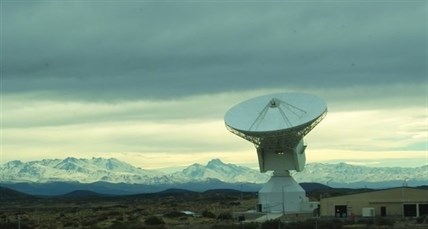
A tracking station in Argentina built by SED Systems of Saskatchewan is shown in a 2012 handout photo.
Image Credit: THE CANADIAN PRESS/HO-European Space Agency/S. Marti
November 08, 2014 - 7:25 PM
MONTREAL - A little-known Canadian company is playing a big role in the European Space Agency's Rosetta mission, the first in history to rendezvous with a comet.
The agency is hoping to drop a lander, the size of a small fridge, on the comet's surface in the coming days — a feat that has never been tried before.
The mission is being carried out with help from Saskatoon's SED Systems, which built three ground stations the space agency uses to communicate with the Rosetta spacecraft.
The orbiter is currently circling Comet 67P/Churyumov-Gerasimenko, which was named after its astronomer discoverers.
Helping understand the origin and evolution of the solar system is the mission's prime objective.
"SED has been involved since the delivery of the first antenna back in 2001," Denis Sirois, the firm's business manager, said in a recent interview.
The first tracking station was built in New Norcia, which is near Perth in Western Australia. The two others followed, in Cebreros, Spain, in 2006 and in Malargue, Argentina, in 2013.
The total cost of the three stations and their 35-metre antennas was between $80 million and $100 million.
Company officials and scientists are now eagerly awaiting this coming Wednesday, which is about three months after the 2900-kilogram spacecraft first arrived at the odd-shaped Comet 67P/C-G.
The plan is for the orbiter to release the 100-kilogram lander.
The Philae lander, named for an island in the Nile, will then attempt to latch on to the icy space body using harpoons fired into the surface.
The shape of the comet, which has a 'head' and a 'body' separated by a narrow neck, has been likened to that of a rubber duck.
Even though it's a relatively small object of about four kilometres in diameter, the comet is moving at speeds up to 135,000 km-h.
Sirois pointed out that since the Rosetta orbiter was launched in March 2004, communications have had to be planned "days and weeks" in advance.
"The furthest away that the spacecraft had been was somewhere in the neighbourhood of a billion kilometres," he said from his office in Saskatchewan.
"So the time it takes for the signal to leave the spacecraft and arrive on Earth is somewhere between 30 and 50 minutes."
Sirois says when the Philae lander touches down, its signals should take about 30 minutes to arrive back on Earth.
And that in itself poses an interesting scientific challenge.
"It's a little bit like Wayne Gretzky used to say: 'You don't pass the puck where the player is, you've got to pass it where he is going to be,'" Sirois said.
"It's the same with sending commands up to this thing because in that 30-minute timeframe — between sending the command on Earth and its arriving at the spacecraft — the spacecraft has moved considerably."
The SED's three ground stations are under the control of the European Space Operations Center in Darmstadt, Germany.
Sirois said it wasn't easy for the Saskatchewan company, with 250 employees, to win the contract to build the first one in 2001.
"The competition was fierce, there was an Italian consortium (and) other European bidders who wanted in on these stations as well and, of course, they had some of the capabilities to do it," he said.
But he said a co-operative effort involving his company and the Canadian Space Agency paid off. Canada also takes part in some European Space Agency programs.
"Because we were quite unknown, it was even more difficult to convince them (ESA) that we had the capabilities to do it," Sirois said.
"But, based on our heritage and our experience, that allowed us to get to the table."
SED has had a history of building ground stations, but mostly in the telecommunications sector.
"After the first contract, we had basically passed the test with ESA and they were now confident in our capabilities," Sirois said.
SED still had to compete to get the contracts for the two other stations, but it had an advantage over its competitors after it built the first one.
The ESA mission is named after the Rosetta Stone, a slab of volcanic basalt found near the Egyptian town of Rashid (Rosetta) in 1799. The slab, with three languages, provided historians with the key to an ancient civilization.
Follow @Peter_R_Space on Twitter
News from © The Canadian Press, 2014